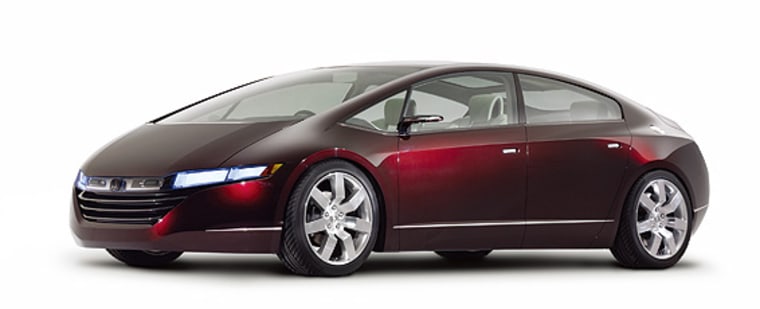Motorists are seeing more hybrids and even some zero-emission fuel-cell vehicles on the road, making it tougher for auto makers to put the “wow” in their green products. But it’s certainly not stopping them from trying.
At the Tokyo Motor Show this year, many carmakers will twin futuristic technologies like advanced fuel cells and drive-by-wire with head-turning designs and quirky concepts to upstage rivals at one of the world’s five biggest auto shows, opening from Oct. 22 to Nov. 6.
Among the concept cars from Toyota, Japan’s top car maker and a leader in clean-vehicle technology, is the gull-winged Fine-X, a new fuel-cell car that has four independently steered wheels which enable it to rotate on the spot.
With no noted output or driving range improvement over its existing fuel-cell vehicle, Toyota is playing up the car for other eco-friendly features such as a body and interior that use biodegradable fibers and plastics.
The maker of the popular Prius hybrid car will also show off a one-seater “mobility machine” called the i-swing, which runs on three wheels at high speeds and upright on two wheels in slow mode. The vehicle is an evolved version of the PM, which stole the limelight at the Tokyo Motor Show two years ago.
Electric car swivels
This time, that privilege will probably go to archrival Nissan’s Pivo concept. The egg-shaped cabin-on-wheels is an all-electric vehicle and uses drive-by-wire technology to allow the cabin to spin around — perfect for exiting a parking space.
Drive-by-wire eliminates the mechanical linkages between cabin and chassis to enable steering, braking and shifting through electronic signals.
The system is not new to the industry, however, having been put prominently on the map by General Motors sleek Hy-wire concept car at the Paris Motor Show in 2002.
“With the Pivo concept, we want to demonstrate the myriad possibilities that drive-by-wire could achieve,” Pivo’s chief designer, Masato Inoue, said at a preview of the car last month.
Pivo uses lithium-ion batteries, which last much longer than those now used in gas-electric hybrid vehicles. Lithium-ion still costs more, but several automakers are working with the batteries in expectations of further cost reductions.
Fuel cell styling touted
Over at Honda’s stand, Japan’s third-biggest automaker will show off the FCX concept, which proposes the future styling of a fuel-cell car once the industry manages to develop smaller fuel-cell stacks and store more hydrogen in smaller tanks.

With the compact mock fuel-cell stack tucked between the driver and passenger seats, and two small hydrogen tanks between the rear wheels, the FCX has an ultra-low floor and more cabin space than fuel-cell cars now being tested on the road.
“This is what we’d like fuel-cell cars to look like,” Honda Executive Chief Engineer Yozo Kami said.
Among non-Japanese brands, DaimlerChrysler will show the F600 Hygenius fuel-cell car for the first time in Japan. The compact model has a driving range of over 250 miles — about 50 miles short of being considered practical.
“This represents a major step towards bringing the fuel-cell drive up to full production maturity,” DaimlerChrysler Research and Technology Chief Thomas Weber said in a statement. The German-U.S. company is aiming to mass-produce zero-emission fuel-cell vehicles some time between 2012 and 2015.
Most auto makers consider that timeline ambitious, however. One fuel-cell car is said to cost at least $1 million to build, not to mention the work needed on infrastructure and legislation to set up hydrogen fuelling stations on public roads.
Electric, hydrogen, gas combo
With those roadblocks in mind, Mazda Motor Corp. has an interim solution: the Premacy Hydrogen RE Hybrid, a close-to-ready minivan concept that can run on gasoline, hydrogen or an electric motor. Mazda says it aims to market the dual-fuel vehicle “in the near future.”
Some of the other green highlights at the show include these concept cars:
- Making its world debut at the Mazda stand is the hydrogen RX-8 rotary engine sports car, which the Japanese automaker plans to begin leasing soon in Japan.
- Suzuki’s Ionis by-wire minicar concept uses fuel-cell technology borrowed from GM, which has 20 percent share in the company. Its light-blue tinted windows and curvy exterior are designed to resemble water — the only by-product of a fuel-cell vehicle.
- Subaru-maker Fuji Heavy Industries B5-TPH concept car is a design study in next-generation crossovers. The hybrid powertrain uses a lithium ion battery co-developed with electronics maker NEC Corp. that can last 15 years.
Conspicuously absent from the list of world debuts is Detroit-based General Motors, whose top brass will also be staying home to deal with growing troubles after former parts-making unit Delphi Corp. filed for bankruptcy last weekend.
